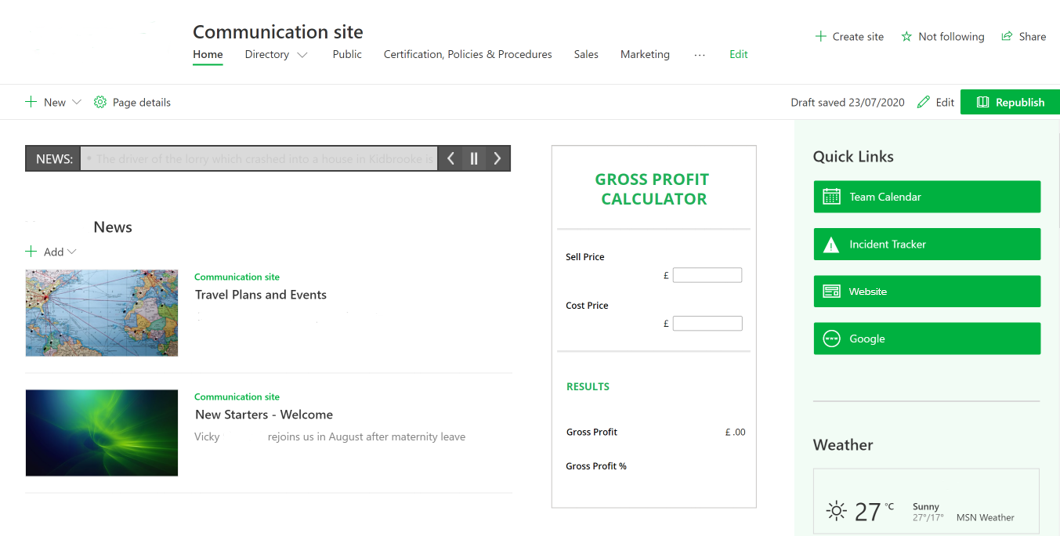Planning is important when it comes to intranets, as they can be completely individual to your organisation.
When considering a new intranet implementation, there are some key steps that we’ve identified that if followed, will ensure the success of your new setup.
If this system is tailored to your organisation, you need to guarantee that it’s tailored in the correct way, and will actually serve the use you need it for.
Identify Stakeholders
The first step in planning a new intranet implementation is to identify all possible stakeholders. This will be anyone who is directly or indirectly affected by the intranet setup, including employees, managers, vendors and clients. By identifying each individual group of stakeholders, you’ll be able to develop and structure your intranet around their individual needs.
Gather Requirements
Once you have gathered research and feedback from users, managers, and stakeholders, the next crucial step is analysing the data collected. This involves carefully examining the information to identify patterns, pain points, and user preferences. Look for common themes and specific user needs that emerge from the research. By understanding these insights, you can create a comprehensive picture of the problem you're trying to solve with the new intranet implementation.
Once the data analysis is complete, it's time to define clear and measurable goals for your intranet project. These goals should be aligned with the identified user needs and should outline the specific outcomes you want to achieve through the intranet implementation. Some examples of goals could be enhancing internal communication, streamlining information sharing, improving employee collaboration, increasing productivity, or simplifying access to important resources.
It's important to involve key stakeholders and decision-makers in the goal-setting process to ensure that the objectives are well-aligned with the overall business strategy. Additionally, setting realistic timelines and allocating appropriate resources are crucial factors to consider at this stage.
With a solid understanding of the problem and well-defined goals, you can now move forward to the next stages of the intranet implementation process.
Select A Software Solution
Conducting thorough research to find the best intranet provider for your organisational needs is a critical step in ensuring the success of your intranet implementation. To start the process, make a list of potential providers and carefully evaluate each one based on specific considerations.
Ease of use is a vital aspect, as you want your intranet to be user-friendly and intuitive for all employees. Look for providers that offer a clean and intuitive interface, easy navigation, and straightforward functionalities that align with your team's technical expertise.
Security is another paramount concern when selecting an intranet provider. Your organisation's sensitive data and information must be protected from unauthorised access or breaches. Ensure that the provider you choose adheres to stringent security protocols, such as data encryption, multi-factor authentication, and regular security updates.
Customisation capabilities are also crucial, as your intranet needs to reflect your organisation's unique culture and workflows. Look for providers that offer extensive customisation options, allowing you to tailor the intranet to your specific requirements, branding, and organisational structure.
Cost is a significant factor for any organisation, so consider the pricing models and licensing options offered by the intranet providers. While some providers might offer attractive initial pricing, be sure to understand the long-term costs, including any potential hidden fees or additional charges for extra features.
We recommend SharePoint, due to its advanced adaptability and straightforward user experience, as well as the added bonus of it being available with most common Microsoft 365 licenses.

Choose A Business Partner
Once you've decided to start a new intranet implementation, the next step is choosing a business partner to support the process.
A good way to do this is by examining the company's credentials and experience with intranets. Try to find evidence that they’ve worked on similar projects in the past, and have an invested interest in intranet implementation.
An experienced partner will have supporting documentation of examples of their work, as well as a dedicated page towards intranets, outlining how they work and what they could do for you.
Monitor And Evaluate
Post implementation, you should constantly be monitoring and evaluating your setup to ensure its continued usability and functionality towards user needs. Regularly gathering feedback from employees and stakeholders will provide valuable insights into how well the intranet is meeting their requirements and whether any improvements or adjustments are necessary.
A proactive and responsive approach from your chosen business partner is essential in this phase. They should be dedicated to supporting your organisation's growth and development by continuously enhancing the intranet's capabilities and adapting it to scale alongside your evolving needs. Regular updates, feature enhancements, and addressing any technical issues promptly are indicative of a strong and reliable partnership.
Additionally, consider conducting periodic performance assessments and benchmarking to gauge the intranet's effectiveness in improving internal communication, collaboration, and productivity.
Successful Intranet Implementation
By following these five steps, you’ll have the best chance at a successful intranet implementation. By planning your intranet before you begin to develop it, you’ll ensure that it accurately reflects organisational requirements and answers user needs.
Akita develops Microsoft SharePoint as an intranet for some of the world’s leading brands and organisations. Discover more about our SharePoint intranet solutions:





